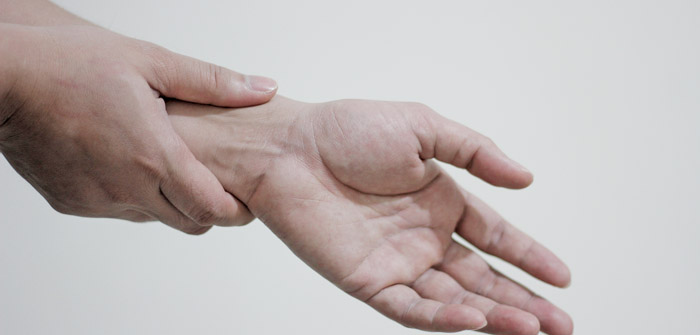(Photo | by Carpal Tunnel Gadgets from FreeImages)
What is Carpal Tunnel?
Most of us attribute Carpal Tunnel Syndrome (CTS) to that numbing, tingling sensation we feel in our hands after sitting at a desk, typing away for hours on end, and in part, that’s true. But carpal tunnel is more than just the occasional discomfort, and it can happen as a result of far more than just typing at a keyboard.
The Mayo Clinic tells us that carpal tunnel is “a narrow passageway surrounded by bones and ligaments on the palm side of your hand,” and that Carpal Tunnel Syndrome is the result of pressure on the median nerve which runs through the forearm to the wrist through the carpal tunnel. When this happens, we feel numbness, tingling and also weakness in the hand.
What are the Causes of Carpal Tunnel Syndrome?
Similar to the idea of monotonous typing at the keyboard – a mild, everyday activity – Carpal Tunnel Syndrome pops up as a result of other normal activities in one’s home or in the workplace. We see it often in those operating vibrating tools such as in construction, those with rheumatoid arthritis, chronic illnesses such as diabetes, and who those are healing from wrist fractures or dislocations. Other factors like obesity, menopause and pregnancy, can all increase the chances of CTS. These are just a few, so be aware that Carpal Tunnel Syndrome can form as a result of other symptoms as well.
What Should I Do When Carpal Tunnel Syndrome Symptoms Appear?
A lot of times, CTS appears gradually, starting with that numbness and/or tingling sensation that we talked about before. Weakness in the hands and wrists (such as involuntarily dropping items that the hand would otherwise be able to grip with no resistance) is a furthering sign that CTS is settling in more thoroughly.
So what should you do to help treat and prevent CTS? Here are a few at-home tips that the Mayo Clinic recommends:
- Limit the force with which you implement movement in your hands and wrists. The Mayo Clinic tells us, “If your work involves a cash register or keyboard, for instance, hit the keys softly. For prolonged handwriting, use a big pen with an oversized, soft grip adapter and free-flowing ink.”
- Be conscious of your form. Bending your wrist all the way up or down may contribute to CTS. Instead, a “relaxed middle position” is what the Mayo Clinic recommends. So for all you keyboard punchers out there, try to keep your keyboards at elbow height or a smidge lower. When operating machinery or going about your daily routine, try not to overexert your wrists.
- Just so, be conscious of good posture. By rolling your shoulders in a poor posture position, compression in your neck muscles can trickle down into your fingers, hands and wrists, causing unwanted tension.
- Make sure that if you are working at a computer, you have a comfortable mouse and keyboard. Part of limiting the force with which you operate also means having the right equipment that doesn’t put strain on your fingers, hands and wrists. This is a good reminder for all our daily routines. Try not to perform actions or operate machinery that is awkward or uncomfortable to grip.
- Take frequent breaks. Prolonged activity performing repetitive tasks can be harmful and further the progress of CTS. The Mayo Clinic instructs us to “gently stretch and bend hands and wrists periodically. Alternate tasks when possible. This is especially important if you use equipment that vibrates or that requires you to exert a great amount of force. Even a few minutes each hour can make a difference.”
- Ice the area in order to reduce inflammation. In this case, cold over heat is going to be your best option for finding relief.
- Utilize simple stretching exercises. Medina Sports and Family Chiropractic lists a couple of easy exercises you can do throughout your day to ease the symptoms of CTS.
-
- Wrist Extension Stretch: This is done by straightening the arm and bending the wrist back. Use the other hand to pull the palm further backward and hold the position for 15 seconds. Do this one-by-one with each finger as well.
- Wrist Flexion Stretch: The arm is straightened in this pose too, however the palm is facing downward. Bend the wrist so the fingers run perpendicular to the ground. Use the opposite hand to pull the fingers toward the body.
Can Chiropractic Care Help Treat Carpal Tunnel Syndrome?
Absolutely! Regular chiropractic care is a great way to stay on top of your CTS. Here are a few techniques we recommend:
Adjustments: Chiropractors may use Diversified Chiropractic (through manual manipulation) or, as we like to recommend, the Activator Method, in order to adjust the area, along with the elbow and spine. This will help to ease the effects of CTS and treat it over a long period of time.
Physical Therapy: Graston technique and cupping are also means for chiropractors or physical therapists to treat CTS. Both are instrument-based modalities designed to relax muscle tissue.
Massage Therapy: A more non-invasive form of treatment, this is a recommended option for relaxing the tension on that median nerve through simple massage.
Bracing: Bracing the area with either a wrist brace or medical taping will limit mobility, which will help to keep those fingers, hands and wrists from overexerting themselves.
How Can I book A Chiropractic Appointment?
Easy! Elk Ridge Chiropractic & Wellness Center is currently accepting new patients. If you are suffering from CTS, or if you think you might be experiencing early symptoms of CTS, give us a call at 541-388-3588, or email us at elkridgechiropractic@gmail.com. We look forward to hearing from you!
Sources:
mayoclinic.org/diseases-conditions/carpal-tunnel-syndrome/symptoms-causes/syc-20355603
medinasportschiropractor.com/how-chiropractor-treats-carpal-tunnel





